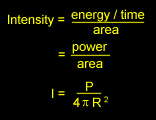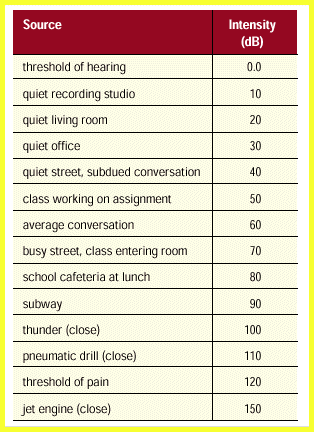



|
The Transmission of Sound Waves and Intensity |
When a tuning fork is struck, it pushes air molecules into each other, which creates a steadily moving area of collision called a compression (C). When the tine moves back, it creates a region of emptiness called a rarefaction (R). In sound waves, a compression is an area of higher than normal air pressure and a rarefaction is an area of lower than normal air pressure.


 Intensity - the average rate of energy flow per unit area across a surface
perpendicular to the direction of
propagation.
Intensity - the average rate of energy flow per unit area across a surface
perpendicular to the direction of
propagation.
 Click here to listen to different intensities of sound.
Click here to listen to different intensities of sound.


The first decibel value, 0 dB, is fixed near the threshold of hearing. The decibel scale does not increase with uniform gradations. A sound 10 times more intense than 0 dB equals 10 dB. A sound 100 times more intense than 0 dB equals 20 dB. A sound 1000 times more intense equals 30 dB, so on and so forth.
The following chart shows decibel (dB) values for various sources of sounds or noise.
Also, as the distance between the source and the person increases the intensity of sound decreases.
| BACK TO TOP |


|